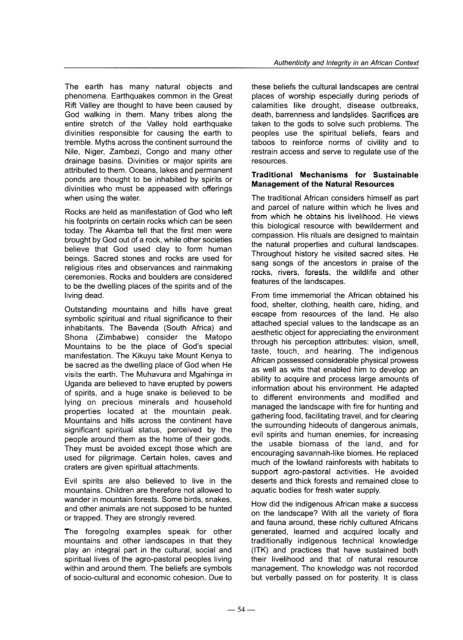Mul - unesdoc - Unesco
Mul - unesdoc - Unesco
Mul - unesdoc - Unesco
You also want an ePaper? Increase the reach of your titles
YUMPU automatically turns print PDFs into web optimized ePapers that Google loves.
The earth has many natural abjects and<br />
phenomena. Earthquakes common in the Great<br />
Rift Valley are thought to have been caused by<br />
God walking in them. Many tribes along the<br />
entire stretch of the Valley hold earthquake<br />
divinities responsible for causing the earth to<br />
tremble. Myths across the continent surround the<br />
Nile, Niger, Zambezi, Congo and many other<br />
drainage basins. Divinities or major spirits are<br />
attributed to them. Oceans, lakes and permanent<br />
ponds are thought to be inhabited by spirits or<br />
divinities who must be appeased with offerings<br />
when using the water.<br />
Rocks are held as manifestation of God who left<br />
his footprints on certain rocks which cari be seen<br />
today. The Akamba tell that the first men were<br />
brought by God out of a rock, while other societies<br />
believe that God used clay to form human<br />
beings. Sacred stones and rocks are used for<br />
religious rites and observances and rainmaking<br />
ceremonies. Rocks and boulders are considered<br />
to be the dwelling places of the spirits and of the<br />
living dead.<br />
Outstanding mountains and hills have great<br />
symbolic spiritual and ritual significance to their<br />
inhabitants. The Bavenda (South Africa) and<br />
Shona (Zimbabwe) consider the Matopo<br />
Mountains to be the place of God’s special<br />
manifestation. The Kikuyu take Mount Kenya to<br />
be sacred as the dwelling place of God when He<br />
visits the earth. The Muhavura and Mgahinga in<br />
Uganda are believed to have erupted by powers<br />
of spirits, and a huge snake is believed to be<br />
lying on precious minerals and household<br />
properties located at the mountain peak.<br />
Mountains and hills across the continent have<br />
significant spiritual status, perceived by the<br />
people around them as the home of their gods.<br />
They must be avoided except those which are<br />
used for pilgrimage. Certain holes, caves and<br />
craters are given spiritual attachments.<br />
Evil spirits are also believed to live in the<br />
mountains. Children are therefore not allowed to<br />
wander in mountain forests. Some birds, snakes,<br />
and other animals are not supposed to be hunted<br />
or trapped. They are strongly revered.<br />
The foregoing examples speak for other<br />
mountains and other landscapes in that they<br />
play an integral part in the cultural, social and<br />
spiritual lives of the agro-pastoral peoples living<br />
within and around them. The beliefs are symbols<br />
of socio-cultural and economic cohesion. Due to<br />
- 54 -<br />
Authenticitv and Intearitv in an African Context<br />
these beliefs the cultural landscapes are central<br />
places of worship especially during periods of<br />
calamities like drought, disease outbreaks,<br />
death, barrenness and landslides. Sacrifices are<br />
taken to the gods to solve such problems. The<br />
peoples use the spiritual beliefs, fears and<br />
taboos to reinforce norms of civility and to<br />
restrain access and serve to regulate use of the<br />
resources.<br />
Traditional Mechanisms for Sustainable<br />
Management of the Natural Resources<br />
The traditional African considers himself as part<br />
and parce1 of nature within which he lives and<br />
from which he obtains his livelihood. He views<br />
this biological resource with bewilderment and<br />
compassion. His rituals are designed to maintain<br />
the natural properties and cultural landscapes.<br />
Throughout history he visited sacred sites. He<br />
sang songs of the ancestors in praise of the<br />
rocks, rivers, forests, the wildlife and other<br />
features of the landscapes.<br />
From time immemorial the African obtained his<br />
food, shelter, clothing, health tare, hiding, and<br />
escape from resources of the land. He also<br />
attached special values to the landscape as an<br />
aesthetic abject for appreciating the environment<br />
through his perception attributes: vision, smell,<br />
taste, touch, and hearing. The indigenous<br />
African possessed considerable physical prowess<br />
as well as wits that enabled him to develop an<br />
ability to acquire and process large amounts of<br />
information about his environment. He adapted<br />
to different environments and modified and<br />
managed the landscape with fire for hunting and<br />
gathering food, facilitating travel, and for clearing<br />
the surrounding hideouts of dangerous animals,<br />
evil spirits and human enemies, for increasing<br />
the usable biomass of the land, and for<br />
encouraging Savannah-like biomes. He replaced<br />
much of the lowland rainforests with habitats to<br />
support agro-pastoral activities. He avoided<br />
deserts and thick forests and remained close to<br />
aquatic bodies for fresh water supply.<br />
How did the indigenous African make a success<br />
on the landscape? With all the variety of flora<br />
and fauna around, these richly cultured Africans<br />
generated, learned and acquired locally and<br />
traditionally indigenous technical knowledge<br />
(ITK) and practices that have sustained both<br />
their livelihood and that of natural resource<br />
management. The knowledge was not recorded<br />
but verbally passed on for posterity. It is class

















